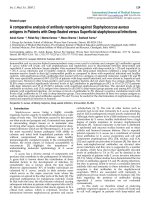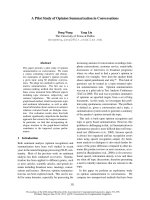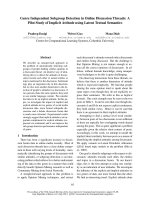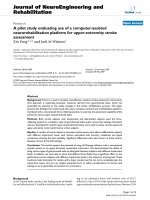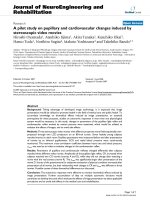Báo cáo y học: "A pilot study of rizatriptan and visually-induced motion sickness in migraineu"
Bạn đang xem bản rút gọn của tài liệu. Xem và tải ngay bản đầy đủ của tài liệu tại đây (181.66 KB, 6 trang )
Int. J. Med. Sci. 2009, 6
212
I
I
n
n
t
t
e
e
r
r
n
n
a
a
t
t
i
i
o
o
n
n
a
a
l
l
J
J
o
o
u
u
r
r
n
n
a
a
l
l
o
o
f
f
M
M
e
e
d
d
i
i
c
c
a
a
l
l
S
S
c
c
i
i
e
e
n
n
c
c
e
e
s
s
2009; 6(4):212-217
© Ivyspring International Publisher. All rights reserved
Research Paper
A pilot study of rizatriptan and visually-induced motion sickness in mi-
graineurs
Joseph M. Furman
1
, Dawn A. Marcus
2
1. Department of Otolaryngology, University of Pittsburgh School of Medicine, Pittsburgh, USA
2. Department of Anesthesiology & Critical Care Medicine, University of Pittsburgh School of Medicine, Pittsburgh, USA
Correspondence to: Joseph M. Furman, Suite 500, Eye & Ear Institute, 203 Lothrop Street, Pittsburgh, PA 15213. Phone:
412-647-2117; Fax: 412-647-2080; Email:
Received: 2009.05.14; Accepted: 2009.08.04; Published: 2009.08.06
Abstract
Background: Limited evidence suggests that rizatriptan given before vestibular stimulation
reduces motion sickness in persons with migraine-related dizziness. The present study was
designed to test whether rizatriptan is also effective in protecting against visually-induced
motion sickness and to test whether rizatriptan blocks the augmentation of motion sickness
by head pain.
Material and Methods: Using randomized double-blind, placebo-controlled methodology,
10 females, 6 with migrainous vertigo (V+) and four without vertigo (V-) received 10 mg ri-
zatriptan or placebo two hours prior to being stimulated by optokinetic stripes. Visual
stimulation was coupled with three pain conditions: no pain (N), thermally-induced hand
pain (H) and temple pain (T). Motion sickness and subjective discomfort were measured.
Results: Motion sickness was less after pre-treatment with rizatriptan for 4 of 10 subjects
and more for 5 of 10 subjects. Augmentation of motion sickness by head pain was seen in 6
of 10 subjects; this effect was blunted by rizatriptan in 4 of these 6 subjects. Subjective dis-
comfort was significantly more noticeable in V+ subjects as compared with V- subjects.
Conclusions: These pilot data suggest that rizatriptan does not consistently reduce visu-
ally-induced motion sickness in migraineurs. Rizatriptan may diminish motion sickness po-
tentiation by cranial pain.
Key words: anxiety, optokinetic, pain, vertigo, vestibular
Introduction
Migrainous vertigo is accepted as a common
cause of episodic vertigo, affecting about 1% of the
population
1
. A recent survey comparing the occur-
rence of vestibular complaints in 327 migraine pa-
tients and 324 controls without frequent headache
reported dizziness or vertigo in 52% of migraine pa-
tients versus 32% of controls (P<0.0001)
2
. Further-
more, 23% of those migraine patients with vestibular
complaints met criteria for the diagnosis of migrain-
ous vertigo. Patients with migraine with aura had
significantly more migraine attacks associated with
vestibular complaints always (15% vs. 10%) or some-
times (22% vs. 5%) (P<0.0001).
Vestibular abnormalities have been identified in
migraineurs when asymptomatic between headache
episodes. A small study comparing interictal vesti-
bular function in individuals with migraine with and
without vertigo and controls (N=15) showed reduc-
tion in mean gain of the semicircular canal-ocular
reflex, a larger modulation component of the oto-
lith-ocular reflex, and increased postural sway during
optic flow testing among individuals with migrainous
Int. J. Med. Sci. 2009, 6
213
vertigo
3
. Recently, a larger study similarly testing
vestibular function in patients with migraine or con-
trols (N=75) identified saccadic pursuit, unilateral
caloric hypofunction, and increased sway velocity on
posturography in individuals with migrainous ver-
tigo
4
. Others have failed to differentiate migraineurs
with and without vertigo, based on specialized ves-
tibular testing
5, 6
.
Motion sickness provides an easily reproduced
vestibular symptom. Motion sickness can be induced
by stimulation of the vestibular receptors via actual
motion or motion of visual surroundings, such as
optokinetic stimuli. Such visually-induced motion
sickness is often accompanied by a sensation of self
motion indistinguishable from sensations experienced
during actual motion. Visually-induced motion sick-
ness can be as severe as that induced by actual mo-
tion. Drummond reported motion sickness symptoms
after exposure to individual motions (e.g., boat, car, or
amusement park rides) in 30-40% of migraineurs,
with motion sickness after viewing visual stimuli
(e.g., simulators or movie screens) in about 20-30%
7
.
Interestingly, motion sickness induced by actual mo-
tion did not predict motion sickness from visual
stimuli. Research by Drummond and Granston
showed that visually-induced motion sickness in mi-
graineurs can be potentiated by combining head pain
with a provocative visual stimulus
8
.
Reducing motion sickness can be accomplished
by avoidance of a provocative stimulation or using
vestibular suppressants. Triptans have been incon-
sistently shown to decrease symptoms in patients
diagnosed with migrainous vertigo
9, 10
. A recent case
report of three women with migrainous vertigo noted
head pain induction or aggravation with resolution of
vertigo after triptan treatment (sumatriptan in 2 pa-
tients and rizatriptan in one patient) of usual vertigo
attacks
11
. Our previous research has suggested in a
small pilot study that rizatriptan, when given orally
two hours prior to exposure to a complex vestibular
stimulation, reduces motion sickness in persons with
migraine-related dizziness
12
. Based upon this ap-
parent protective effect of rizatriptan for motion
sickness induced by actual motion in migraineurs, we
embarked upon a comparable study of visu-
ally-induced motion sickness. We were especially
interested in replicating and extending research by
Drummond and Granston
8
that showed that visu-
ally-induced motion sickness in migraineurs can be
potentiated by combining head pain with a provoca-
tive visual stimulus, the “Drummond Effect”. In the
present study, using a small number of subjects, we
addressed the hypotheses that rizatriptan acts as a
protective agent against visually-induced motion
sickness in migraineurs and that rizatriptan interferes
with the Drummond Effect.
Methods
This double-blind placebo controlled pilot study
compared the development of visually-induced mo-
tion sickness after pre-treatment with a typical mi-
graine dose of the serotonin agonist rizatriptan or
placebo. Rizatriptan was selected for this study based
upon its superior ability to cross the blood-brain bar-
rier
13
. This trial was conducted in accordance with the
guidelines of the International Conference on Har-
monization for Good Clinical Practice and the study
protocol was approved by a local Institutional Review
Board. Each study participant provided informed
consent prior to study enrollment.
For this pilot study, data from ten females with
migraine headache and a history of motion sickness
are reported. Eligible subjects were identified via local
paid advertisements. Subjects were required to be
21-45 years old with a diagnosis of ICHD-II migraine
with or without aura
14
. Subjects were initially
screened by telephone for migraine using the previ-
ously-validated Migraine Assessment Tool
15
, with the
diagnosis confirmed through clinical evaluation by a
board-certified neurologist. Eligible subjects were
required to report a typical migraine frequency of at
least 2 episodes per month and have previously
demonstrated tolerability to any triptan medication.
Subjects were also required to report a history of mo-
tion sickness symptoms with actual or visu-
ally-induced motion. Subjects were excluded if they
had heart disease, uncontrolled hypertension, a fam-
ily history of early myocardial infarction, were current
smokers, or were pregnant. Subjects were also ex-
cluded if they had neurologic or otologic disease aside
from migraine or migraine-related dizziness or a di-
agnosis of hemiplegic or basilar migraine. Subject
candidates were subsequently evaluated by a neu-
rotologist using the validated Structured Interview for
Migrainous Vertigo
16
and clinical assessment to
categorize subjects as having migraine with (V+) or
without (V-) migrainous vertigo, based on previously
published criteria by Neuhauser, et al.
17
.
During the screening visit, subject candidates
were evaluated with testing of visual and auditory
acuity, along with vestibular screening tests. Eye po-
sition data were collected using infrared cameras
housed in form-fitted goggles for the following tests:
ocular motor screen, gaze and spontaneous nystag-
mus search, positional nystagmus search, caloric irri-
gation, and earth vertical axis rotational testing. Dur-
ing ocular motor screening, subjects were placed in
front of a screen onto which a laser target or dark bars
Int. J. Med. Sci. 2009, 6
214
were projected. Subjects were instructed to watch the
laser target as it moved in different patterns or count
stripes as they moved in a clockwise or counter-
clockwise manner. For gaze and spontaneous nys-
tagmus search, subjects were asked to look straight
ahead and then left, right, up, and down for 10-15
seconds in each position. The testing was repeated
with and without visual fixation. Positional nystag-
mus assessed using infrared goggles with eyes open
in darkness. Subjects were asked to recline in the su-
pine position, then with head turned right and left
and finally on his/her right side and then left side.
Each position was held approximately 20 seconds.
Caloric irrigation was performed using a closed-loop
irrigator with the ear stimulated with water at 30° and
44°C. Both temperatures were performed in each ear.
Subjects were asked to count by 2’s for 40 seconds
after irrigation completion to keep from suppressing
the vestibular response. For earth vertical axis rota-
tional testing, subjects were rotated sinusoidally in the
dark with frequencies varying from 0.02 to 1.0 Hz and
amplitudes of 25 to 150 degrees/second and constant
velocity of 60 degrees/second. Subjects were ex-
cluded if, on baseline screening, they had corrected
vision worse than 20/40 in each eye or abnormalities
on clinical audio-vestibular laboratory testing.
Eligible candidates were then scheduled to re-
turn for two experimental visits, scheduled at least
one week apart. Subjects were required to have been
without any headache for 48 hours prior to each test-
ing visit and have not used any triptan for at least 1
week prior to each experimental visit. Vital signs were
recorded and then subjects were treated orally in a
blinded fashion with either 10 mg of rizatriptan (R) or
a placebo (P) in identical capsules two hours prior to
exposure to optokinetic stripes. Each subject received
R on one testing day and P on the other. The order of
treatment was determined randomly by the inde-
pendent pharmacists, who created the randomization
scheme by drawing treatment assignments from a
blinded container. The investigator administering the
drug, the technicians performing testing, and the
subject were blinded to treatment assignment. The
Investigational Drug Service provided the unidenti-
fiable drug in a container labeled only with the visit
number. The randomization scheme was not un-
blinded until the data were collected for the entire
study. Blood pressure, heart rate, and the develop-
ment of any adverse events were monitored for the
two hours after ingestion of study drug. Two hours
was selected as the optimal time for exposure to a
potentially motion-sickness provoking stimulus so
that rizatriptan could obtain its peak mi-
graine-relieving effect
18
.
Two hours after study-drug administration,
subjects were exposed to three 15-minute trials of
full-field optokinetic stripes rotated horizontally us-
ing a constant velocity of 30 degrees/second. Either
clockwise or counterclockwise motion was used for
all trials for each subject. Testing was identical on both
experimental days. Prior to visual stimulation, sub-
jects were assessed using the Motion Sickness Scale
(MSS)
19
to establish a baseline. Subjective Units of
Discomfort (SUDs) also were assessed. The MSS in-
cludes assessments of nausea, skin color, cold sweat-
ing, increased salivation, drowsiness, headache, and
dizziness with eyes open and closed. Severity of ab-
normalities in each category are rated by the subject
and technician, with a range of scores for nausea of 0
to 16, for skin color of 0 to 8, for cold sweating of 0 to
8, salivation of 0 to 8, drowsiness of 0 to 8, and head-
ache and dizziness as described below. If MSS ex-
ceeded 16 at any time, the trial was discontinued.
SUDs rates anxiety from 0 (none) to 10 (panic level
anxiety). MSS and SUDs, recorded approximately
every 2 minutes during and after exposure. On each
day of testing, subjects were exposed to three different
pain conditions presented in random order that were
coupled with the optokinetic visual stimulation: no
pain (N), hand pain (H), and temple pain (T). During
the N condition, subjects viewed rotating vertical
black and white stripes projected onto a wall. Every 2
minutes during the N trial, subjects were asked to rate
their motion sickness and anxiety. During the H con-
dition, 2 minutes after beginning stripe viewing, the
subject’s non-dominant hand was immersed in 32ºC
water for 2 minutes then immersed in 2ºC ice water
for 30 seconds and then back into the warm bath. Ice
water immersion was repeated at 8 and 12 minutes,
with subjects rating motion sickness and anxiety
throughout. During T, subjects were asked to place a
small block of ice at their temple using a gloved hand
for 30 seconds, starting 4 minutes after stripe viewing.
Subjects were asked to select that side of the head that
was most commonly affected with pain during a mi-
graine. Ice to the temple was repeated at 8 and 12
minutes. Subjects rated their motion sickness and
anxiety throughout. The order of pain conditions was
assigned to each subject randomly, with at least 2
minutes of rest time between trials. Testing was dis-
continued at the subject’s request or if the MSS
reached 16 or above.
Data analysis
The overall motion sickness score for each pain
condition was determined by subtracting the MSS
score obtained just prior to exposure to the optoki-
netic stimulus for that pain condition from the aver-
Int. J. Med. Sci. 2009, 6
215
age MSS score obtained during and 2 minutes after
the 15-minute exposure. Overall SUDs for each pain
condition was determined by subtracting the SUDs
score obtained just prior to exposure to the optoki-
netic stimulus for that pain condition from the aver-
age SUDs score obtained during and 2 minutes after
the 15-minute exposure.
Comparisons between pain conditions and be-
tween testing sessions within each subject were
evaluated using non-parametric analyses. Compari-
sons between V+ and V- groups and between groups
with and without visual motion sensitivity were per-
formed using the Wilcoxon rank sum test.
Results
Fourteen persons were identified as possible
study candidates. Of these, one was excluded because
of abnormal baseline caloric responses, one was ex-
cluded due to technical reasons, and two subjects
withdrew prior to completing the study. The 10 sub-
jects completing the study were all female, ranging in
age from 25 to 42 years old (mean 34.6 +/- 6.9 years).
(See Table 1.) Six subjects met Neuhauser criteria for
migraine-related vertigo (V+) and four had no com-
plaints of vertigo (V-). Each of the ten subjects toler-
ated the experimental procedures well and had no
adverse effects from the drug or the induction of pain.
There were no changes in heart rate or blood pressure
that required discontinuation of an experiment. Three
trials were terminated early because MSS exceeded
16.
Motion sickness induced by moving optokinetic
stripes was higher on average during placebo trials
than during rizatriptan trials in 4 of 10 subjects, higher
with rizatriptan in 5 of 10 subjects, and unchanged for
one subject. Motion sickness was not different be-
tween the V+ group and the V- group based on the
Wilcoxon rank-sum test. Motion sickness was higher
for the T condition than for the H condition for 6 of 10
subjects for placebo trials. For these 6 subjects, 4 of
them showed a decreased or absent Drummond Effect
with rizatriptan. That is, rizatriptan interfered with
the potentiation of motion sickness symptoms by
concomitant temple pain in 4 of 6 subjects. This effect
of rizatriptan was equally apparent in the V+ group
and V- groups. Motion sickness was not different
between those subjects with a history of visu-
ally-induced motion sickness vs. those subjects with-
out a history of visually-induced motion sickness us-
ing the Wilcoxon rank-sum test.
Data regarding the amount of anxiety induced
by the combinations of pain and visual motion based
on SUDs indicated that during testing following in-
gestion of rizatriptan the V+ group was more anxious
overall than the V- group (p<.05) based on the Wil-
coxon rank-sum test. Rizatriptan did not appear to
consistently either reduce or increase anxiety during
testing.
Table 1. Demographics of the subject group.
Motion Sickness HistorySubject Num-
ber
Age Gender Aura/No Aura Diagnosis
Actual Visual
Prior headache response to triptan
1 32 Female Aura Vertigo x Sumatriptan – benefit
2 39 Female No Aura Vertigo x x Sumatriptan – benefit
3 37 Female Aura Non-Vertigo x x Rizatriptan, Sumatriptan, Eletriptan – no
benefit
Frovatriptan – benefit
4 23 Female Aura Vertigo x Sumatriptan – no benefit; Rizatriptan- benefit
5 40 Female Aura Vertigo x Sumatriptan – benefit
6 29 Female No Aura Non-Vertigo x x Zolmitriptan – no benefit; Eletriptan – benefit
7 41 Female Aura Non-Vertigo x Sumatriptan, Rizatripitan (benefit unknown)
8 43 Female Aura Vertigo x Sumatriptan – benefit;
9 26 Female Aura Vertigo x Frovatriptan – benefit
10 33 Female Aura Non-Vertigo x Eletriptan – benefit
Discussion
Our initial pilot study regarding the effect of
triptans on motion sickness combined actual motion,
i.e., vestibular stimulation, with rizatriptan
12
. That
study suggested a possible protective effect of a sero-
tonin agonist for motion sickness in migraineurs with
migraine-related dizziness. The pilot study reported
herein extends this line of research by combining a
visual motion sickness-inducing stimulus with pain
and pre-treatment with rizatriptan. In this study, ri-
zatriptan does not appear to reduce visually-induced
motion sickness but rizatriptan may reuce the poten-
tiation of motion sickness by cranial pain. This effect
does not appear to be greater in subjects with mi-
grainous vertigo. That is, we found that rizatriptan
Int. J. Med. Sci. 2009, 6
216
may interfere with a previously recognized phe-
nomenon wherein laboratory-induced head pain but
not extremity pain potentiates visually-induced mo-
tion sickness in migraineurs, i.e., the Drummond Ef-
fect
8
. The exact mechanism whereby rizatriptan in-
terferes with the Drummond Effect is uncertain. Ri-
zatriptan may interfere with connections between
central pain pathways and the vestibular nuclei.
Motion sickness is a behavioral response to both
self-motion and visually-induced motion that has no
known purpose
20
. Motion sickness is especially
common in migraineurs
21, 22
, occurring with a fre-
quency of about 50%
23
. This increased susceptibility
to motion sickness in migraineurs is of uncertain
cause and can occur with both self motion, i.e., vesti-
bular-induced motion sickness, and with visual mo-
tion, i.e., visually-induced motion sickness. We have
theorized previously that increased activity in vesti-
bulo-autonomic projections, possibly via serotonin,
may account for increased symptoms in migraineurs
24, 25
Recently, an alternate theory of motion sickness
has been developed that links motion sickness to al-
terations in the so called “velocity storage” portion of
the central vestibular system
26, 27
. Interestingly, al-
though velocity storage appears to be unchanged in
patients with migraine, our previous studies
3, 12
showed that both motion sickness and velocity stor-
age decreased with rizatriptan.
Rizatriptan is known to influence the central
nervous system
13, 28
and in particular, rizatriptan
probably influences the vestibular nuclei since sero-
tonin receptors have been found in the vestibular nu-
clei
29
and serotonin influences the activity of neurons
in the vestibular nuclei
30
. Vestibulo-autonomic
pathways
20
may be especially sensitive to rizatriptan
in that rizatriptan is known to decrease nausea in mi-
graine
31
but also may have a side effect of dizziness
32,
33
. Also, serotonin agonists have been shown to de-
crease emesis in animal models
34-36
and tryptophan
depletion has been found to increase visually-induced
nausea and dizziness in migraineurs
7
. Based on our
results and the known effects of rizatriptan and sero-
tonin, we hypothesize that rizatriptan provides bene-
fit regarding motion sickness in some migraineurs by
influencing central vestibulo-autonomic pathways
both directly and indirectly.
Our subjects’ anxiety, as reflected by subjective
discomfort, was greater in the subjects with migrain-
ous vertigo. This finding is consistent with the exces-
sive vestibular symptoms in this group. Possibly, this
finding is based on enhanced activity in the circuitry
linking the vestibular nuclei to more rostral structures
such as the parabrachial nucleus
37
.
Although not uniformly successful, this pilot
study provides additional impetus for the possibility
of using triptans for prophylaxis against motion
sickness, especially in those migraineurs who have
dizziness associated with headache. The current
treatment for motion sickness includes scopolamine
as a prophylaxis agent
38
. To date, there is no literature
aside from our pilot studies that suggest using a trip-
tan for motion sickness prophylaxis.
Limitations of this study include the small
number of subjects and the inclusion of only females.
The gender inequality may have been less important
given the finding by Park and Hu
39
that there was no
gender difference for visually-induced nystagmus.
Our sample also may be atypical of clinical samples of
migraineurs given the high number of V+ subjects
identified. Although Neuhuaser identified V+ in only
9% of migraineurs
17
, a migraine sample recruited at
our center for a previously reported study found V+
in 41% of adult migraineurs self-selecting to partici-
pate in a research study
16
. Future research in this area
should include a larger number of subjects. Also, it
may be of interest to assess motion sickness prophy-
laxis in migraineurs using a CGRP antagonist
40
, when
these agents become more widely available.
Conclusions
These pilot data suggest that rizatriptan may in-
terfere with the potentiation of visually-induced mo-
tion sickness in migraineurs by cranial pain. Ri-
zatriptan did not appear to alter visually-induced
motion sickness overall nor did rizatriptan alter sub-
jective discomfort. Subjects with migrainous vertigo
exhibited more discomfort during induction of visu-
ally-induced motion sickness.
Acknowledgements
The authors wish to acknowledge the technical
assistance of Anita Lieb, Diana Ross, and Susan Stre-
linski, and statistical assistance from Dr. Gregory
Marchetti. This study was funded by an investiga-
tor-initiated research grant from Merck.
Conflict of Interest
The authors have declared that no conflict of in-
terest exists.
References
1. Neuhauser HK, Radtke A, von Brevern M, et al. Migrainous
vertigo: prevalence and impact on quality of life. Neurology
2006;67(6):1028-33.
2. Vukovic V, Plavec D, Galinovic I, Lovrencic-Huzjan A, Budisic
M, Demarin V. Prevalence of vertigo, dizziness, and migrainous
vertigo in patients with migraine. Headache
2007;47(10):1427-35.




